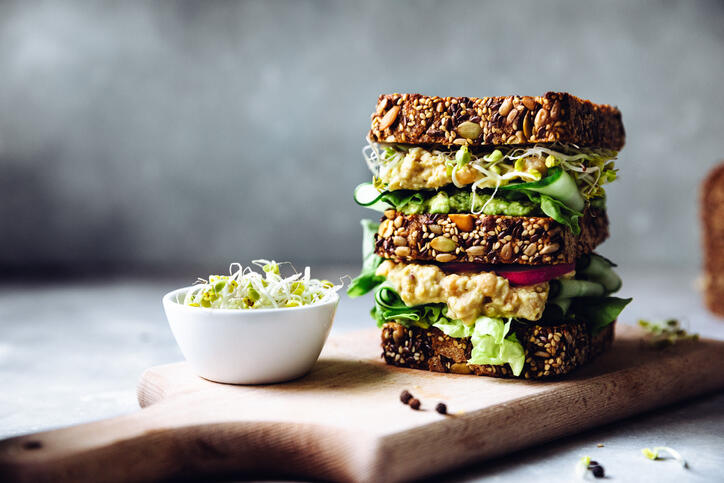9 Iron-Packed Veggies That Will Help You Up Your Daily Intake—and Boost Your Energy Levels

Folks are often talking about and plotting how to get enough protein, but between the growing public interest in getting a healthy fix of it and widespread knowledge that the stuff is super helpful for replenishing post-workout energy, it might be time to momentarily shift our collective focus to getting enough of a different vital nutrient. Making sure there's enough iron in your diet, for instance, can be tricky—especially for vegans and plant-based eaters. Luckily, there are plenty of veggies to help keep your body running properly, and plenty of 'em might well be on your dinner plate already.
What is iron, anyway?
When your body takes in iron, it processes the nutrient and turns it into two different proteins: hemoglobin in red blood, which has the important job of making sure oxygen gets properly distributed throughout your body, and myoglobin, which delivers oxygen to your muscles. If there's not enough iron in your body—whether that's due to your diet or blood loss (and yes, losing blood during your period totally counts!)—it's possible to develop anemia, a condition that can make you feel tired, dizzy, and give you headaches. Additionally, your immune system can also take a hit if you have depleted levels of iron.
To avoid feeling lethargic and lousy overall, it's crucial to make sure you're getting the Recommended Dietary Allowance (RDA) of the mineral, and that differs from person to person. For women ages 19 to 50, the guideline is to eat at least 18 mg per day. If you're pregnant, that number goes up to 27 mg. And because iron from plants (non-heme) isn't as easily absorbed as iron from animal products (heme), it's recommended that vegans eat 1.8 times the standard daily amount—so for most women, that means aiming for 32 milligrams a day.
Furthermore, to really ensure you’re getting enough iron, it’s also important to note *how* you consume your legumes and vegetables high in iron. This comes down to the fact that serving your veggies raw versus cooked affects the amount of iron in your dish. For instance, beans and lentils, says Caroline Thomason, RD, have less bioavailable iron after cooking. One cup of cooked spinach, on the other hand, contains more iron than one cup of raw spinach. The reason for this increase in nutrients, Thomason explains, is simply because some foods tend to shrink when heated. (In other words, you’ll need more cooked spinach than you did raw spinach to fill up the same-sized cup.)
9 best legumes and vegetables high in iron to get your fix
There's one super-simple way to make sure you're eating enough iron every day, especially if you eat plant-based: filling your plate with a whole lot of iron-rich, body-boosting vegetables and legumes. As an added bonus, you'll get plenty of other important vitamins and minerals in the process, too. So, which ones should you pile on your plate? Start planning your meals around these nine high-iron superstar ingredients.
1. Spinach
In addition to being a vegetable high in iron, Thomason says spinach also offers a variety of other nutrients including vitamin C, magnesium, and a hearty dose of fiber. That said, she also notes that this leafy green’s iron is not as readily available for the body when compared to meat, but there are ways to increase this (more on this later!).
-
Raw: 1 mg per cup
-
Cooked: 6 mg per cup
2. Mushrooms
To maximize the amount of iron you get from mushrooms, consuming them cooked is definitely the way to go. “Cooking mushrooms can increase the total amount of iron, mostly because the mushrooms shrink in size when they are cooked,” Thomason says. In particular, oyster mushrooms, she adds, offer the highest iron content compared to other mushrooms.
-
Raw: .3 mg per cup
-
Cooked: 3 mg per cup
3. Asparagus
Asparagus really packs a punch when it comes to iron content, when consuming it raw, specifically. Thomason points out that a cup of raw asparagus has almost 3 mg of iron.
-
Raw: 3 mg per cup
-
Cooked: 1 mg per cup
4. Potatoes
Potato lovers, rejoice. The vegetable is another high source of plant-based iron delivering 2 mg of iron in a medium-sized potato. Additionally, Thomason adds, potatoes are a great source of vitamin C which helps improve iron absorption.
-
Raw: 2 mg per medium potato
-
Cooked: 2 mg per medium potato
5. Black beans
Delivering an impressive 4 mg of iron per cup, cooked black beans don’t mess around in the nutrition department. Thomason also notes that they are an excellent source of soluble fiber which can help decrease cholesterol and improve digestion.
-
Raw: 10 mg per cup
-
Cooked: 4 mg per cup
6. Chickpeas
When you really want to step up your iron consumption, chickpeas, also known as garbanzo beans, are a good option. One cup of cooked chickpeas provides 5 mg of iron. Plus, Thomason says, “these little beans are high in potassium and magnesium as well—two major electrolytes that help manage fluid retention and blood pressure.”
-
Raw: 9 mg per cup
-
Cooked: 5 mg per cup
7. Lentils
Thomason describes lentils as an “iron-packed superfood” thanks to their nearly 7 mg of iron per cooked cup. “Like beans, lentils are high in fiber and nutrients like potassium which can help lower blood pressure,” she says.
-
Raw: 13 mg per cup
-
Cooked: 7 mg per cup
8. Broccoli
Although broccoli isn’t as high in iron as other veggies, about 1 mg per cup, Thomason notes it still makes the list for its other redeeming qualities. “Broccoli is high in vitamin C, vitamin K, and potassium,” she says. “These nutrients work to keep our skin and bones healthy.”
-
Raw: 4 mg per bunch
-
Cooked: 4 mg per bunch
9. Navy beans
Like other beans, navy beans too are a vegetable high in iron prodiving about 4 mg of iron per cooked cup. Also, Thoman says, “Navy beans are high in fiber and can be helpful in lowering chronic disease risk through our diet.”
-
Raw: 11 mg per cup
-
Cooked: 4.3 mg per cup
Non-vegetable foods high in iron
Vegetables aren’t the only food sources of iron. Here are a few more Thomason recommends.
1. Red meat: For non-vegans and vegetarians, red meat can help boost your iron intake. According to Thomason, red meat is the most bioavailable iron source, meaning it’s readily absorbed and used by the body.
2. Dried fruit: Dried fruit is also high in iron. In particular, Thomason says dates and apricots are popular for their iron content and they get bonus points for also containing vitamin C, which helps with iron absorption.
3. Shellfish, including clams, and oysters: When it comes to seafood, Thomason says that clams, oysters, and other forms of shellfish (such as shrimp and crab) are great iron sources and also easy for the body to absorb.
4. Iron-fortified cereals: “Fortified cereal is required to have iron,” Thomason says. “So, if you are getting a healthy dose of whole grains, you are well on your way to an adequate iron diet.”
The best ways to absorb more iron
While eating iron-packed veggies is a great start, there are some simple ways to help your body better absorb the mineral, one of them being pairing the food with vitamin C. When you're planning your meals, try to combine one of the above veggies with another food that's high in the vitamin, like any citrus, chard, broccoli, red or green bell pepper, kiwi, strawberries, tomatoes, cantaloupe, or papaya, Stanford Medicine reports.
Another way to take in more iron is to simply pair iron-rich veggies with other healthy iron-rich foods. Toss some nuts and seeds into your meals, as those are jam-packed with the mineral—particularly pumpkin seeds, sesame seeds, cashews, and pistachios. And plant-based protein can be a win, too: tofu alone contains 7 mg per 1/2 cup. You can also cook your food using a cast-iron pan, which—fun fact!—can up the amount of iron you're getting.
While vitamin C can help increase absorption as well, there are other foods and beverages that do the exact opposite, making it harder for your body to get enough iron. If you're low, cut down on coffee and tea, dairy products, high-fiber foods, and wine and beer. Once you find the right balance in your diet, getting that 18-plus mg per day will be a cinch, even if that means occasionally reducing the amount you guzzle of your favorite cold brew. (Best part? The increased energy you'll feel from consuming more vegetables high in iron will more than make up for the caffeine lapse.)
The post 9 Iron-Packed Veggies That Will Help You Up Your Daily Intake—and Boost Your Energy Levels appeared first on Well+Good

